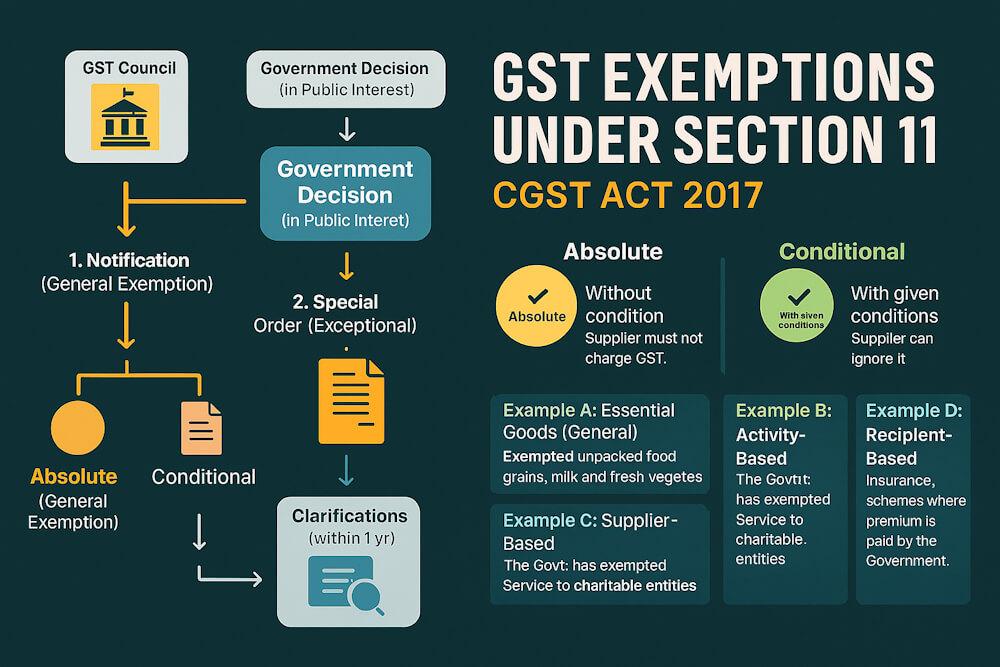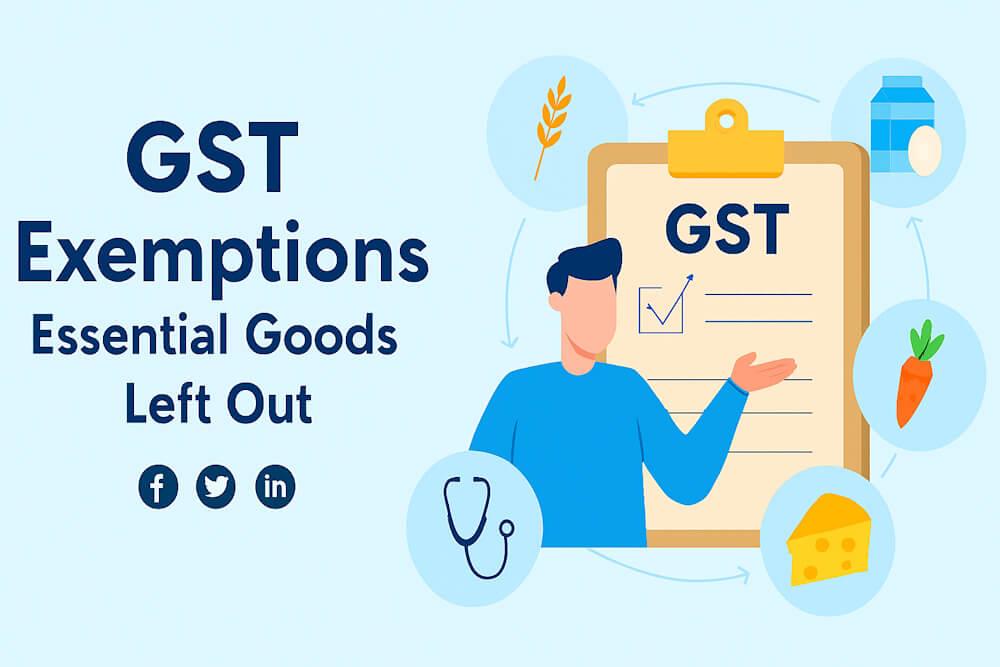The Goods and Services Tax (GST) system in India is designed to simplify indirect taxation and ensure fairness in collection. But there are many cases where the government exempts certain goods or services from tax, either completely or partially, in the public interest.
The power to grant such exemptions lies in Section 11 of the Central Goods and Services Tax (CGST) Act, 2017 and Section 6 of the Integrated Goods and Services Tax (IGST) Act, 2017. In this article, we’ll break down these sections, how exemptions are issued, the types of notifications involved, and what real-life examples show how this system works.
1. Legal Basis for Granting Exemptions under GST
Section 11 – CGST Act, 2017
This section empowers the Central Government, upon the recommendation of the GST Council, to exempt goods or services from the whole or part of the tax levied under the Act.
There are three main sub-sections under Section 11 that explain how exemptions are issued, modified, and clarified.
2. Section 11(1): General Power to Grant Exemption
Under Section 11(1), if the government believes it is necessary in the public interest, it can, through a notification, exempt any specified goods or services:
- Either absolutely (without any conditions) or
- Subject to conditions (with restrictions)
The exemption can cover the whole or part of the tax, and it takes effect from the date mentioned in the notification.
Example
Suppose the government wants to reduce costs for consumers on essential commodities such as milk or grains. It may issue a notification under Section 11(1) fully exempting those items from GST.
This is known as a general exemption notification — it applies to everyone who supplies or consumes those items.
3. Section 11(2): Special Order for Exceptional Circumstances
Sometimes, certain cases arise that require urgent or unique exemptions.
Under Section 11(2), the government can issue a special order — not a general notification — to exempt specific goods or services under exceptional circumstances.
This special order:
- Is based on individual cases
- Must state the exceptional nature of the situation
- Is still issued on the recommendation of the GST Council
Example
Imagine a flood-hit region where the government wants to exempt the supply of relief materials from GST for a short duration. Instead of issuing a general notification (which applies nationwide), it can issue a special order only for that region and for that limited purpose.
4. Section 11(3): Explanation for Clarification (with Retrospective Effect)
Sometimes, confusion arises about the scope or applicability of an exemption notification. In such cases, the government can issue an “explanation” within one year of the original notification or order.
This explanation helps clarify what the exemption covers — and it is treated as if it was part of the original notification from the beginning.
That means such clarifications are retrospective, not prospective.
5. Section 11(4): Meaning of “Absolute Exemption”
The explanation under Section 11 also states that if a supply has been absolutely exempted from GST, the supplier cannot collect tax on it.
For example:
- If “fresh milk” is exempted absolutely, a milk distributor cannot charge GST from customers even voluntarily.
- Similarly, if an exemption is for only part of the tax, the supplier cannot charge GST beyond the effective rate prescribed.
6. Summary Table: Powers under Section 11
| Sub-section | Type of Power | Who Issues | Basis | Effect |
| 11(1) | General Exemption (Notification) | Government | Public Interest | Prospective |
| 11(2) | Special Exemption (Specific Order) | Government | Exceptional Case | Case-based |
| 11(3) | Clarificatory Explanation | Government | Clarify Scope | Retrospective |
| Explanation (Sec 11) | Defines absolute exemption rule | Government | Mandatory nature | Supplier cannot collect GST |
7. Absolute vs Conditional Exemption – The Core Difference
Under GST, exemptions are broadly classified into two types — absolute and conditional.
A. Absolute Exemption
- Granted without any conditions
- Suppliers must not charge GST
- Exemption is mandatory
Example: If the government exempts unbranded flour (atta, maida, besan) under an unconditional notification, no registered dealer can voluntarily collect GST on it.
B. Conditional Exemption
- Granted subject to certain conditions
- Supplier can choose to either avail or ignore it
- Optional in nature
Example: A training program may be exempt only if 75% of its cost is borne by the government. If not, the supplier can decide to opt out of the exemption and pay GST.
8. Flow of Exemption Process (Simplified Visual)
GST Council Recommendation
↓
Government Decision (in Public Interest)
↓
1. By Notification (General Exemption)
→ Absolute / Conditional
OR
2. By Special Order (Exceptional Case)
→ Individual exemption order
↓
Clarifications (Explanation within 1 year)
→ Retrospective applicability
9. How Section 11 Connects with IGST and SGST
The same structure applies under Section 6 of the IGST Act, which gives identical powers to the government to exempt inter-state supplies.
State GST Acts also mirror Section 11, ensuring that both Central and State Governments can issue exemption notifications within their jurisdiction for public interest.
10. Practical Examples from GST Notifications and Law
Let’s review some of the examples and illustrations directly drawn from your ICAI PDF related to how Section 11 and exemption powers work:
Example 1: General Exemption via Notification
When the government exempted essential goods such as unpacked food grains, milk, and fresh vegetables through a notification, it used its power under Section 11(1). This ensured that basic items remain affordable to the general public.
Example 2: Activity-Based Exemption
Certain activities or transactions are exempted irrespective of who provides them. Example:
- Services of transfer of a going concern (entire business or part of it)
- Warehousing of rice Both these exemptions are notified under Section 11(1).
Example 3: Supplier-Based Exemption
In some cases, exemption depends on who provides the service. Example:
- Services provided by Central/State Governments where consideration does not exceed ₹5,000
- Services by charitable entities registered under Section 12AA/12AB of the Income Tax Act
These are general exemptions issued via notification under Section 11(1).
Example 4: Recipient-Based Exemption
Here, the exemption depends on who receives the service. Example:
- Services provided to Central or State Government under an insurance scheme where the premium is fully paid by the Government.
- Training programs where 75% or more of the total expenditure is borne by the Government.
Example 5: Supplier + Recipient-Based Exemption
Certain services are exempt only if both supplier and recipient are specified. Example:
- Services provided by Employees’ State Insurance Corporation (ESIC) to employees covered under the ESI Act, 1948.
- Services by National Pension System (NPS) Trust to its members in exchange for administrative fees.
Both examples come directly from the exemption notification list, which the government issues under its Section 11 powers.
11. The Role of the GST Council
The GST Council’s recommendation is a mandatory prerequisite for all exemptions. The Council reviews:
- Revenue impact
- Social importance of the service or product
- Economic benefit to the general public
Only after the Council’s approval can the government issue an exemption notification or special order.
This ensures transparency and uniformity across states.
12. Retrospective Exemptions – Why They Matter
Retrospective clarifications are crucial because they help taxpayers avoid disputes. For instance, before Circular No. 120/39/2019, some taxpayers had confusion over whether certain service entries applied from the date of the new notification or its explanation.
The retrospective clarification ensured uniformity and prevented unnecessary litigation.
13. Impact of Exemptions on Business and ITC
Businesses dealing in exempt supplies must remember:
- They cannot collect GST on exempt items.
- They cannot claim Input Tax Credit (ITC) on purchases used for those exempt supplies.
Hence, businesses must carefully evaluate whether opting for conditional exemptions makes financial sense.
14. Key Takeaways
- Section 11 of the CGST Act empowers the government to issue GST exemptions by notification or special order.
- Exemptions are always based on public interest and Council recommendations.
- Absolute exemptions are mandatory, while conditional exemptions are optional.
- Clarificatory explanations issued within one year have retrospective effect.
- Notifications like 11/2017 CT (R) show how new entries and explanations are added under this power.
- Both Central and State Governments can use this authority for goods or services under their jurisdiction.
15. Conclusion
Section 11 of the CGST Act forms the backbone of India’s GST exemption policy. It gives the government flexibility to react to economic conditions, public needs, or emergencies.
Whether through a broad notification exempting essential commodities or a targeted special order for a disaster-hit region, this provision ensures that GST remains not just a tax mechanism but also a public-interest tool.
With clear examples, structured powers, and a one-year window for clarifications, Section 11 ensures transparency, fairness, and adaptability in the GST framework — a balance between revenue and relief.

